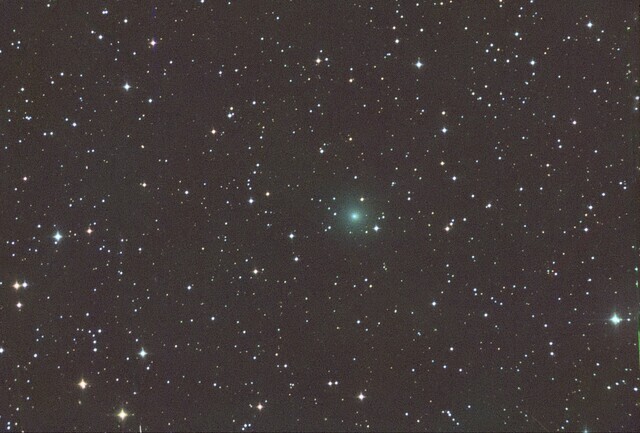 Michael Jaeger captured this recent image of Comet C/2025 A6 Lemmon. Used with permission. Comet Lemmon is one of 5 bright comets headed toward Earth. Read more about them below.
Michael Jaeger captured this recent image of Comet C/2025 A6 Lemmon. Used with permission. Comet Lemmon is one of 5 bright comets headed toward Earth. Read more about them below.
5 bright comets approaching Earth
Time to dust off your binoculars or telescope and seek out that dark-sky site, because five bright comets are on their way. Bright is definitely a relative term when we talk about comets. Most comets swinging through our solar system are incredibly faint. These five comets headed our way will be bright enough to see with small amateur telescopes. And one comet might be visible with the unaided eye!
The approaching comets include:
- C/2025 A6 (Lemmon), closest to Earth on October 21, 2025
- C/2025 K1 (Atlas), closest to Earth on November 24-25, 2025
- 3I/Atlas, the 3rd interstellar object discovered, closest to Earth on December 18-19, 2025
- 24P/Schanmasse, closest to Earth on January 4, 2026
- C/2024 E1 (Wierzchos), closest to Earth on February 17, 2026
EarthSky will guide you to these comets as they get closer. But, for now, let’s talk about the first one approaching, which might also be the brightest of these five.
Comet Lemmon
Meet Comet C/2025 A6 (Lemmon). The 60-inch (1.5-meter) telescope at Mt. Lemmon, Arizona, discovered it on January 3, 2025. With more than 115 observation reports of this comet, scientists have been able to trace its orbit. They’ve determined that Comet Lemmon orbits the sun every 1,396 years. So this comet’s last visit to the solar system’s inner regions and Earth’s vicinity occurred around the year 629. And after this sighting of Comet Lemmon in 2025, it won’t return until the year 3421.
Currently, Comet Lemmon is in the dawn sky in the constellation Gemini. The comet is showing signs of increased activity and has brightened quickly during the last month, from around magnitude 16.5 to 11 (the lower the number, the brighter).
Japanese comet expert Seiichi Yoshida estimates that if Comet Lemmon continues this trend, it might reach magnitude 5 or 4. That means it might become visible to the unaided eye from dark sites.
However, the comet’s recent increase in brightness might just be a temporary outburst. Some estimates say that at its closest and brightest it could only get to around magnitude 7.5. But that would be still good for observations using small telescopes … just not bright enough to see with the unaided eye.
Comets are well known to be unpredictable and erratic. So the only way to know if it gets bright is to observe it during the next few weeks. Closest approach to Earth is on October 21, 2025. Meanwhile, perihelion – or closest approach to the sun – will be on November 8, 2025.
Finder charts for Comet Lemmon
The good news is that during closest approach in October, Comet Lemmon is in the sunset sky. Find a good observing site with no obstructions to the western horizon so you can observe and photograph this “once in a lifetime” comet. Our finder charts are for the Northern Hemisphere. To get a precise chart for your location, visit Stellarium.org.
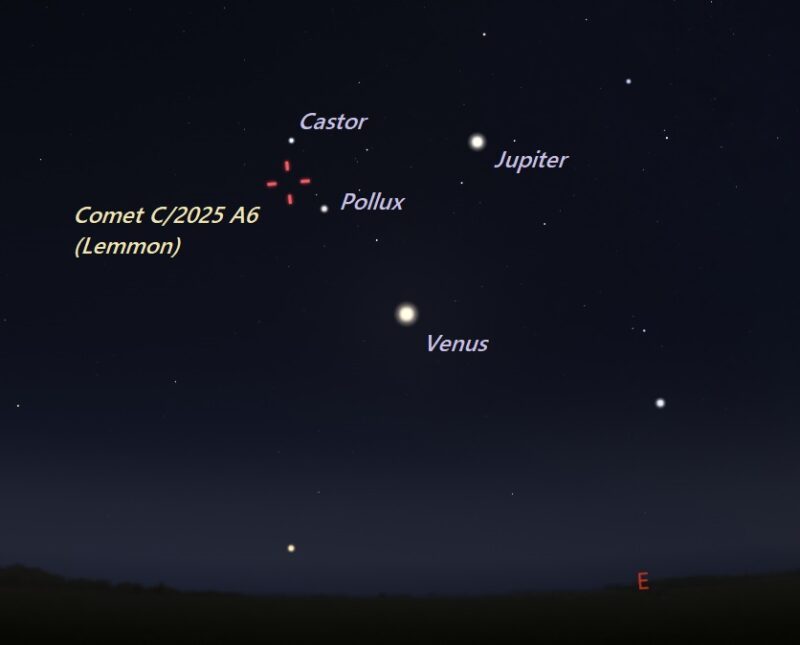 Finder chart for Comet C/2025 A6 Lemmon on August 23, 2025. Leading up to the comet’s closest approach, it will be in the morning sky. Look toward the east before sunrise. The comet is close to the twin stars of Gemini, Castor and Pollux. Image via Eddie Irizarry/ Stellarium.
Finder chart for Comet C/2025 A6 Lemmon on August 23, 2025. Leading up to the comet’s closest approach, it will be in the morning sky. Look toward the east before sunrise. The comet is close to the twin stars of Gemini, Castor and Pollux. Image via Eddie Irizarry/ Stellarium.
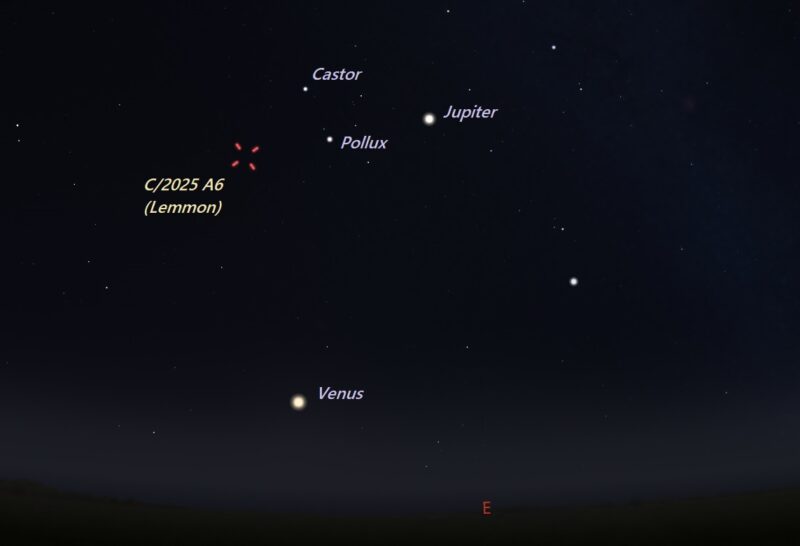 Finder chart for Comet C/2025 A6 Lemmon on September 6, 2025. Look east before dawn. Image via Eddie Irizarry/ Stellarium.
Finder chart for Comet C/2025 A6 Lemmon on September 6, 2025. Look east before dawn. Image via Eddie Irizarry/ Stellarium.
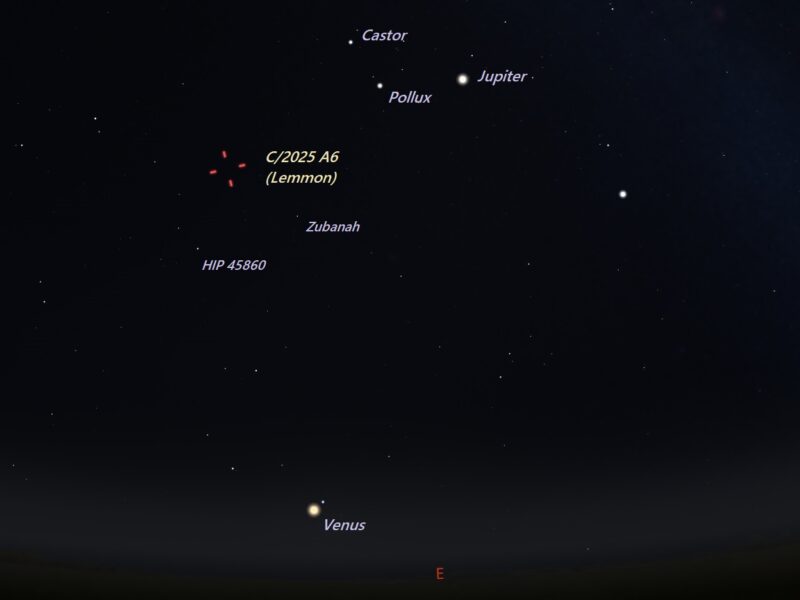 Finder chart for Comet C/2025 A6 Lemmon on September 20, 2025. Look east before dawn. Image via Eddie Irizarry/ Stellarium.
Finder chart for Comet C/2025 A6 Lemmon on September 20, 2025. Look east before dawn. Image via Eddie Irizarry/ Stellarium.
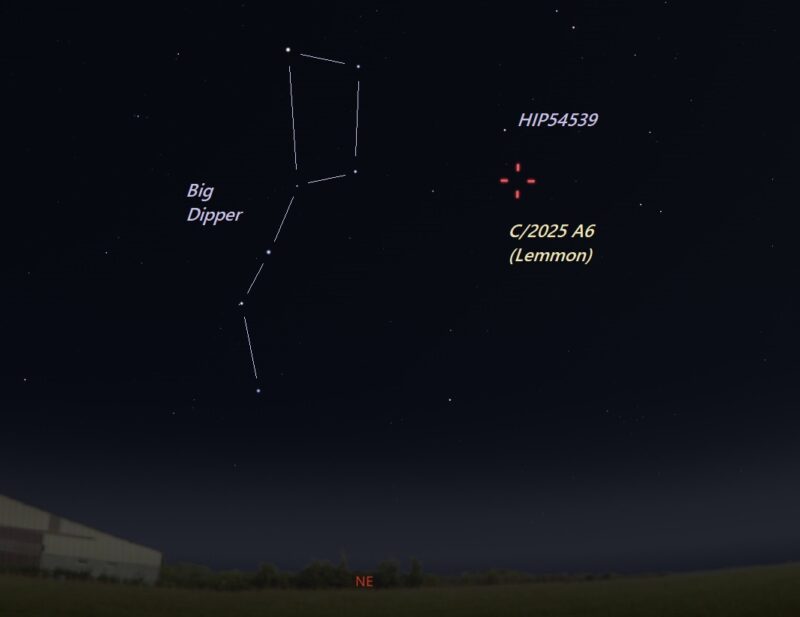 Finder chart for Comet C/2025 A6 Lemmon on October 11, 2025. Look northeast after sunset. Image via Eddie Irizarry/ Stellarium.
Finder chart for Comet C/2025 A6 Lemmon on October 11, 2025. Look northeast after sunset. Image via Eddie Irizarry/ Stellarium.
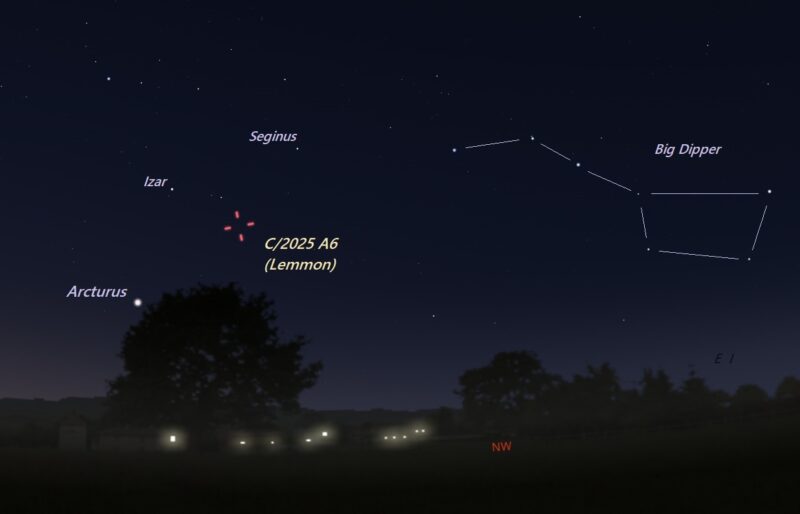 Finder chart for Comet C/2025 A6 Lemmon on October 20, 2025. Look northwest after sunset. Image via Eddie Irizarry/ Stellarium.
Finder chart for Comet C/2025 A6 Lemmon on October 20, 2025. Look northwest after sunset. Image via Eddie Irizarry/ Stellarium.
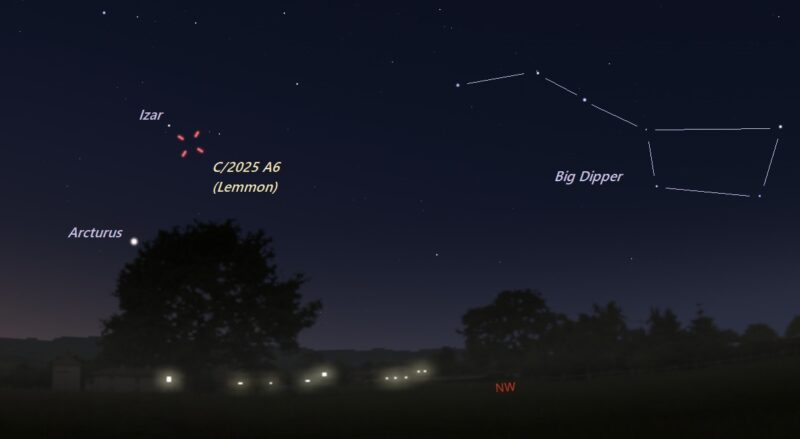 Finder chart for Comet C/2025 A6 Lemmon on October 21, 2025. Look northwest toward the bright star Arcturus in Boötes. Image via Eddie Irizarry/ Stellarium.
Finder chart for Comet C/2025 A6 Lemmon on October 21, 2025. Look northwest toward the bright star Arcturus in Boötes. Image via Eddie Irizarry/ Stellarium.
Bottom line: There are currently 5 bright comets heading toward Earth. The one that will arrive first, Comet Lemmon, might be visible with the unaided eye. Charts here.
Eddie Irizarry
View Articles
About the Author:
Eddie Irizarry of the Sociedad de Astronomía del Caribe (Astronomical Society of the Caribbean) has been a NASA Solar System Ambassador since 2004. He loves public outreach and has published multiple astronomy articles for EarthSky, as well as for newspapers in Puerto Rico. He has also offered dozens of conferences related to asteroids and comets at the Arecibo Observatory.
Asteroid 33012EddieIrizarry, a 7.8 km space rock, has been named in his honor.